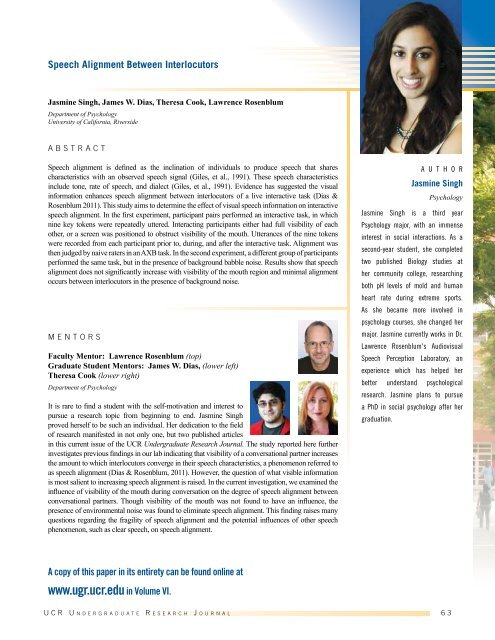Undergraduate Research Journal
Undergraduate Research Journal
Undergraduate Research Journal
Create successful ePaper yourself
Turn your PDF publications into a flip-book with our unique Google optimized e-Paper software.
Speech Alignment Between Interlocutors<br />
Jasmine Singh, James W. Dias, Theresa Cook, Lawrence Rosenblum<br />
Department of Psychology<br />
University of California, Riverside<br />
ABSTRACT<br />
Speech alignment is defined as the inclination of individuals to produce speech that shares<br />
characteristics with an observed speech signal (Giles, et al., 1991). These speech characteristics<br />
include tone, rate of speech, and dialect (Giles, et al., 1991). Evidence has suggested the visual<br />
information enhances speech alignment between interlocutors of a live interactive task (Dias &<br />
Rosenblum 2011). This study aims to determine the effect of visual speech information on interactive<br />
speech alignment. In the first experiment, participant pairs performed an interactive task, in which<br />
nine key tokens were repeatedly uttered. Interacting participants either had full visibility of each<br />
other, or a screen was positioned to obstruct visibility of the mouth. Utterances of the nine tokens<br />
were recorded from each participant prior to, during, and after the interactive task. Alignment was<br />
then judged by naive raters in an AXB task. In the second experiment, a different group of participants<br />
performed the same task, but in the presence of background babble noise. Results show that speech<br />
alignment does not significantly increase with visibility of the mouth region and minimal alignment<br />
occurs between interlocutors in the presence of background noise.<br />
MentorS<br />
Faculty Mentor: Lawrence Rosenblum (top)<br />
Graduate Student Mentors: James W. Dias, (lower left)<br />
Theresa Cook (lower right)<br />
Department of Psychology<br />
It is rare to find a student with the self-motivation and interest to<br />
pursue a research topic from beginning to end. Jasmine Singh<br />
proved herself to be such an individual. Her dedication to the field<br />
of research manifested in not only one, but two published articles<br />
in this current issue of the UCR <strong>Undergraduate</strong> <strong>Research</strong> <strong>Journal</strong>. The study reported here further<br />
investigates previous findings in our lab indicating that visibility of a conversational partner increases<br />
the amount to which interlocutors converge in their speech characteristics, a phenomenon referred to<br />
as speech alignment (Dias & Rosenblum, 2011). However, the question of what visible information<br />
is most salient to increasing speech alignment is raised. In the current investigation, we examined the<br />
influence of visibility of the mouth during conversation on the degree of speech alignment between<br />
conversational partners. Though visibility of the mouth was not found to have an influence, the<br />
presence of environmental noise was found to eliminate speech alignment. This finding raises many<br />
questions regarding the fragility of speech alignment and the potential influences of other speech<br />
phenomenon, such as clear speech, on speech alignment.<br />
A U T H O R<br />
Jasmine Singh<br />
Psychology<br />
Jasmine Singh is a third year<br />
Psychology major, with an immense<br />
interest in social interactions. As a<br />
second-year student, she completed<br />
two published Biology studies at<br />
her community college, researching<br />
both pH levels of mold and human<br />
heart rate during extreme sports.<br />
As she became more involved in<br />
psychology courses, she changed her<br />
major. Jasmine currently works in Dr.<br />
Lawrence Rosenblum's Audiovisual<br />
Speech Perception Laboratory, an<br />
experience which has helped her<br />
better understand psychological<br />
research. Jasmine plans to pursue<br />
a PhD in social psychology after her<br />
graduation.<br />
A copy of this paper in its entirety can be found online at<br />
www.ugr.ucr.edu in Volume VI.<br />
U C R U n d e r g r a d u a t e R e s e a r c h J o u r n a l 6 3














